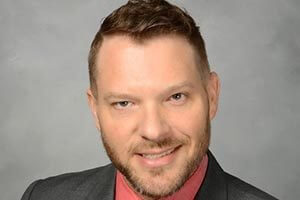Jonn Bailey, assistant professor of pharmacy practice at Shenandoah University, is revolutionizing his patient-centered care course by introducing a curriculum highlighting health care needs for the transgender community.

Bailey is based at the Inova Center for Personalized Health in Fairfax. When it came time to teach his students about treating special populations of people, he found that there was nothing in the teaching module about transgender patients and/or gender identity.
Bailey decided to change that, incorporating transgender medical care into the curriculum even though he knew it would take some getting used to by his students.
You’ve got to flip your entire way of thinking and be mindful of both biologic sex and gender identity when appropriately treating the complete patient.”
Jonn Bailey | Assistant Professor of Pharmacy
Bailey is a member of the LGBTQ community and the National Center for Transgender Equality (NCTE), an advocacy organization for the transgender community. He has partnered with various organizations in Virginia to bring together groups to identify and break down barriers in transgender care and to provide community outreach at health events.
The LGBTQ community is dear to Bailey’s heart. His transgender friends have told him firsthand accounts of medical encounters with providers who have been unknowledgeable regarding appropriate treatment for transgender individuals, while other providers, they say, have at times been degrading.
That’s why Bailey spends the first semester of his Patient-Centered Care II class building both empathy and understanding for the transgender population. He begins by showing a documentary and then provides an introduction to transgender people, their challenges, transgender terminology and how to approach their medical care with empathy. Students learn what medications they might need, what gender affirmation is and how to communicate with transgender patients using proper gender pronouns.
In the second semester, students learn to treat patients using evidence-based guidelines.
Treating the transgender population
The transgender population is underserved and underrepresented, according to Bailey. It faces discrimination, misunderstanding and mistreatment both inside and outside of the medical profession.
Rates of HIV and injection drug use are often higher among the transgender population. Avoidance of medical screenings and appropriate treatment can contribute to higher rates of STIs/STDs. In addition, use of black market medications and other inappropriately administered products such as silicone can lead to dangerous health outcomes.
Transgender individuals will also sometimes undergo risky gender affirmation procedures and techniques without the supervision of medical professionals due to a lack of trust in the medical community or lack of financial resources/insurance coverage to obtain the appropriate care.
“There’s often a high level of substance abuse and depression due to a lack of community and family support provided to transgender individuals,” Bailey said.
Students must learn to be sensitive and to not alienate their transgender patients. Communication is huge.
Researching student reactions
Teaching about transgender care is limited at most universities because a focused approach to medical care for the transgender community has only come to the forefront over the past 3-5 years.
Bailey’s curriculum delves much more extensively into the topic than most schools.
I’ve been at three different universities, and Shenandoah is the only one teaching this subject matter. They’re more progressive in their curriculum.”
Jonn Bailey | Assistant Professor of Pharmacy
Bailey is involved in research projects trying to understand and bridge the gap in health care access for the transgender community. The gap stems from students’ lack of knowledge about transgender patients, which may lead to reduced levels of empathy for this population as well as a deficiency in the students’ ability to provide appropriate guideline-based care.
Through his research, he surveys students before and after the learning modules to see if there is any change in their approach and care. His hope in the future is to develop a process that tracks students’ learning in clinical experiences with this population over time.
So far, student reception in his class has been a “mixed bag.” Most students, according to Bailey, respond very well. Some will email him and express thanks for opening their eyes to this population.
“A very small portion have been very uncomfortable with the topic,” Bailey said.
Jennifer Bingham, a second-year pharmacy student, is helping Bailey on his analysis of whether the transgender component in the class is influencing students’ attitudes and knowledge. As part of the research, they plan to retrospectively look at pre-survey versus post-survey results from October and mid-November to see what, if any, knowledge has been gained or if a measurable increase in empathy can be identified.
“Diversity training has always centered around race and women,” Bingham said. “The transgender population has not been visible. It’s been kind of a side-piece, a joke on TV or a drag queen. But there’s so much more. When we include the diversity of the LGBTQ community, we want to make sure it’s not that one image we see in the media.”
Bailey adds, “It is imperative that we distinguish between sex, sexuality, gender expression and gender identity. We must treat people as a complete person for who they are. This is how we can ensure that we eliminate health disparities that exist and optimize health outcomes for all individuals.”




